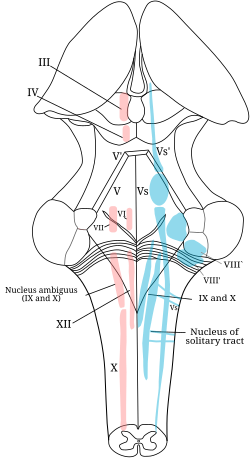| Cranial nerve nucleus | |
|---|---|
 The cranial nerve nuclei schematically represented; dorsal view. Motor nuclei in red; sensory in blue. (The olfactory and optic centers are not represented.) | |
| Details | |
| Identifiers | |
| Latin | nucleus nervi cranialis |
| NeuroLex ID | nlx_28532 |
| TA98 | A14.1.00.004 |
| TA2 | 5857 |
| FMA | 54501 |
| Anatomical terms of neuroanatomy | |
This article includes a list of references, related reading, or external links, but its sources remain unclear because it lacks inline citations .(October 2022) |
A cranial nerve nucleus is a collection of neuron cell bodies (gray matter) in the brain stem that is associated with one or more of the cranial nerves. Axons carrying information to and from the cranial nerves form a synapse first at these nuclei. Lesions occurring at these nuclei can lead to effects resembling those seen by the severing of nerve(s) they are associated with. All the nuclei except that of the trochlear nerve (CN IV) supply nerves of the same side of the body.



